Financial Accounting Report: Sole Trader & Company Accounts
VerifiedAdded on 2020/11/23
|17
|1393
|275
Report
AI Summary
This financial accounting report provides a comprehensive overview of key concepts and practices in financial accounting. It begins by introducing the double-entry bookkeeping system, detailing its application through journal entries and ledger accounts for a sample business. The report then explains the creation and purpose of a trial balance, emphasizing its role in identifying errors and preparing financial statements. Furthermore, it delves into the preparation of final accounts, including income statements and balance sheets, with adjustments for accruals and prepayments. The report illustrates these concepts by preparing financial statements for both a sole trader and a company, offering practical insights into the application of accounting principles in different business structures. Finally, the report concludes by summarizing the importance of financial accounting in organizational record-keeping and performance assessment.
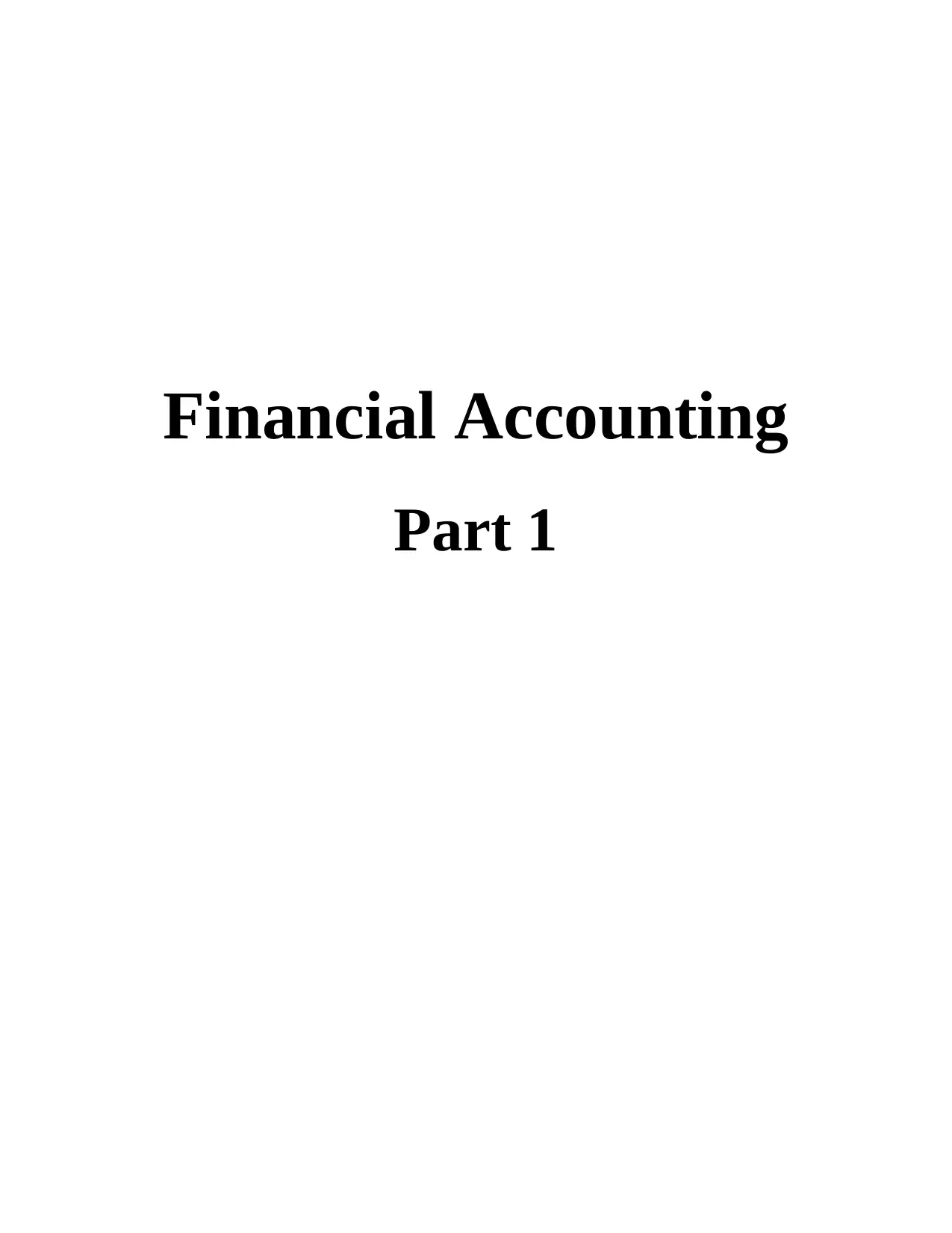
Financial Accounting
Part 1
Part 1
Paraphrase This Document
Need a fresh take? Get an instant paraphrase of this document with our AI Paraphraser
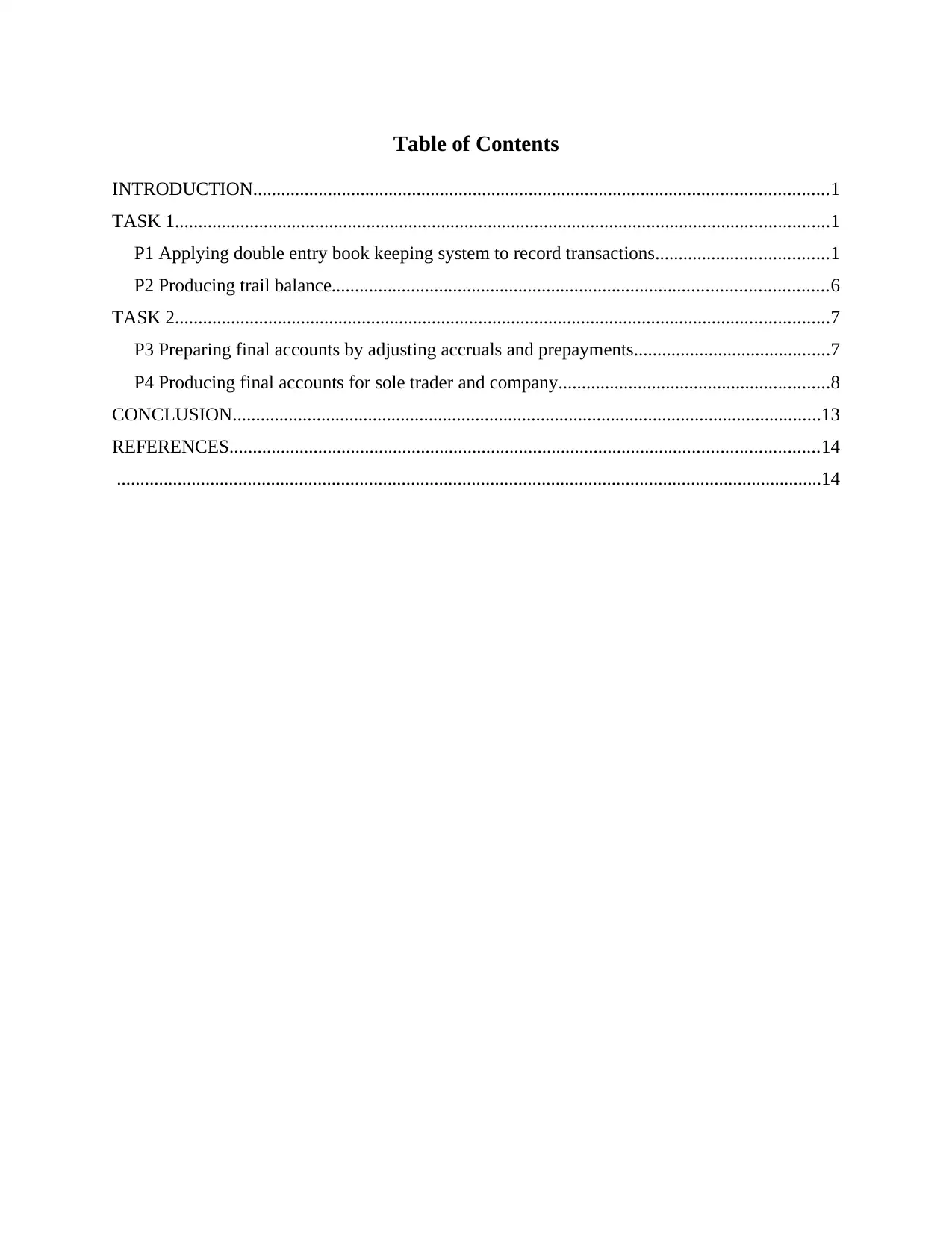
Table of Contents
INTRODUCTION...........................................................................................................................1
TASK 1............................................................................................................................................1
P1 Applying double entry book keeping system to record transactions.....................................1
P2 Producing trail balance..........................................................................................................6
TASK 2............................................................................................................................................7
P3 Preparing final accounts by adjusting accruals and prepayments..........................................7
P4 Producing final accounts for sole trader and company..........................................................8
CONCLUSION..............................................................................................................................13
REFERENCES..............................................................................................................................14
.......................................................................................................................................................14
INTRODUCTION...........................................................................................................................1
TASK 1............................................................................................................................................1
P1 Applying double entry book keeping system to record transactions.....................................1
P2 Producing trail balance..........................................................................................................6
TASK 2............................................................................................................................................7
P3 Preparing final accounts by adjusting accruals and prepayments..........................................7
P4 Producing final accounts for sole trader and company..........................................................8
CONCLUSION..............................................................................................................................13
REFERENCES..............................................................................................................................14
.......................................................................................................................................................14

⊘ This is a preview!⊘
Do you want full access?
Subscribe today to unlock all pages.

Trusted by 1+ million students worldwide

INTRODUCTION
Financial accounting is a system of recording and analysing all financial transactions in
accounting statements and books. The main aim of this project report is to build an
understanding about framework of financial statements and their applications. As a junior
accountant in TaxAssist Accountants which is a small accountancy firm, various financial
statements are prepared and analysed. Double book keeping system is discussed in detail along
with trial balance of the given transactions. In order to develop final accounts, income statements
and balance sheets of two business structures that is company and sole proprietorship are
prepared.
TASK 1
P1 Applying double entry book keeping system to record transactions
Book keeping is a process of recording all the transactions in accounting statements and
books in order to record them so that they can be accessible whenever they is any requirement.
These transactions can be recorded using various methods and one of the most used and
beneficial method of book keeping is double entry. Under double entry book keeping system all
transactions are recorded using two sides that is debit and credit. This method is considered as a
standard due to which all business firms has to follow it except for small firms. This concept of
double entry is based on the fact that every transaction will impact on at least two accounts. Two
elements of this system are debit and credit. Debit is an entry which is recorded at left side of an
account and credit is a transaction which is transacted at right side of an account. In order to
fulfil the requirements of this system both of these sides must be equal. Using this method,
journal entries and ledger accounts of Muhammad's business are developed which are mentioned
below:
Journal entries – This is the first step in the process of financial accounting and is used
to record all transactions and events of a business organisation. All transactions are first
identified and the analysed in order to ascertain their impact on accounts. Journal entries using
specific format are developed below:
1
Financial accounting is a system of recording and analysing all financial transactions in
accounting statements and books. The main aim of this project report is to build an
understanding about framework of financial statements and their applications. As a junior
accountant in TaxAssist Accountants which is a small accountancy firm, various financial
statements are prepared and analysed. Double book keeping system is discussed in detail along
with trial balance of the given transactions. In order to develop final accounts, income statements
and balance sheets of two business structures that is company and sole proprietorship are
prepared.
TASK 1
P1 Applying double entry book keeping system to record transactions
Book keeping is a process of recording all the transactions in accounting statements and
books in order to record them so that they can be accessible whenever they is any requirement.
These transactions can be recorded using various methods and one of the most used and
beneficial method of book keeping is double entry. Under double entry book keeping system all
transactions are recorded using two sides that is debit and credit. This method is considered as a
standard due to which all business firms has to follow it except for small firms. This concept of
double entry is based on the fact that every transaction will impact on at least two accounts. Two
elements of this system are debit and credit. Debit is an entry which is recorded at left side of an
account and credit is a transaction which is transacted at right side of an account. In order to
fulfil the requirements of this system both of these sides must be equal. Using this method,
journal entries and ledger accounts of Muhammad's business are developed which are mentioned
below:
Journal entries – This is the first step in the process of financial accounting and is used
to record all transactions and events of a business organisation. All transactions are first
identified and the analysed in order to ascertain their impact on accounts. Journal entries using
specific format are developed below:
1
Paraphrase This Document
Need a fresh take? Get an instant paraphrase of this document with our AI Paraphraser

General Ledger – This is a set of accounts which are prepared to keep record of all
financial transactions in an organisation. Every account which is prepared has unique record as it
includes summarisation of each type of asset, equity, liability and expense. Some of these
accounts which are prepared from above entries are cash account, bank account purchases
account and many more.
2
financial transactions in an organisation. Every account which is prepared has unique record as it
includes summarisation of each type of asset, equity, liability and expense. Some of these
accounts which are prepared from above entries are cash account, bank account purchases
account and many more.
2
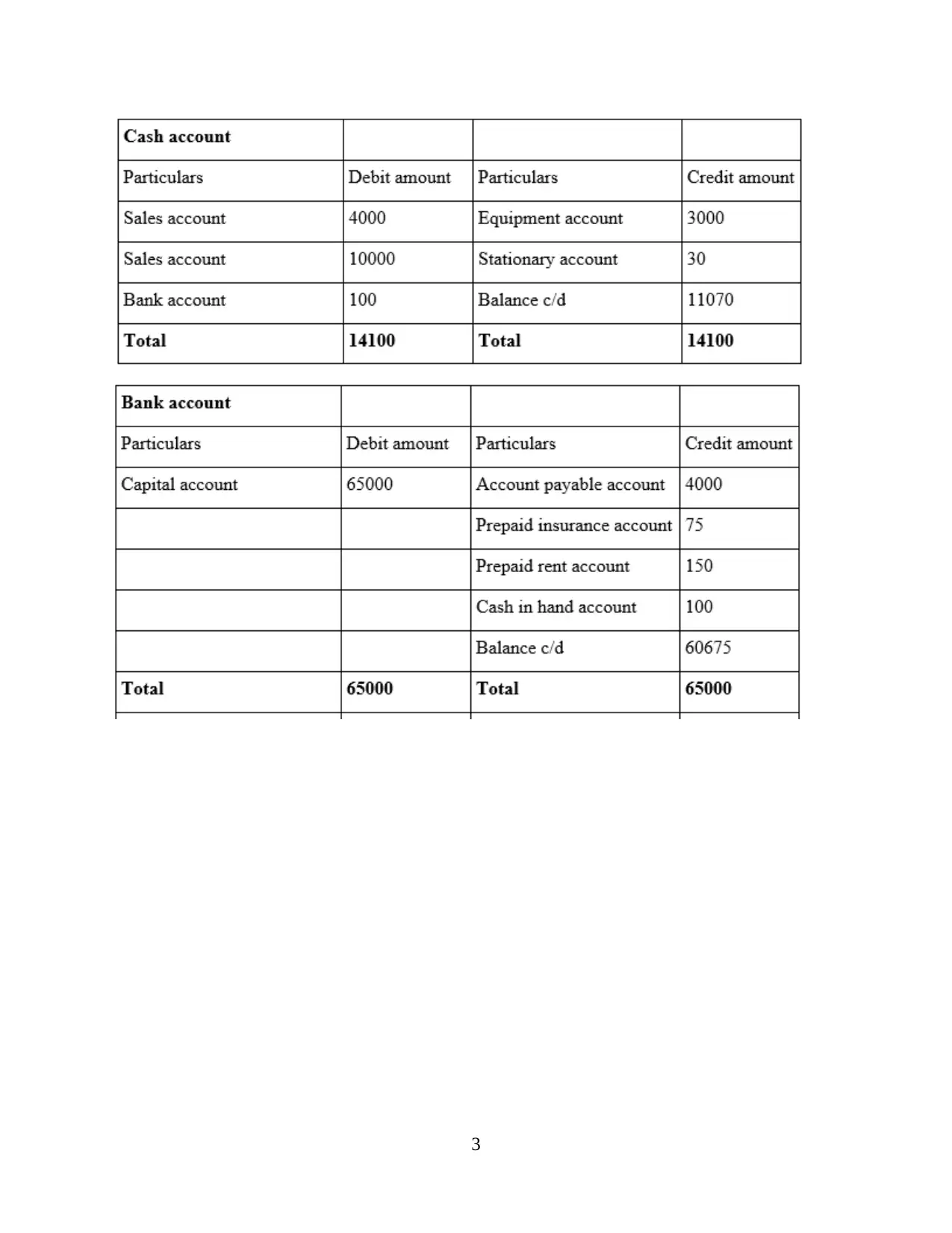
3
⊘ This is a preview!⊘
Do you want full access?
Subscribe today to unlock all pages.

Trusted by 1+ million students worldwide
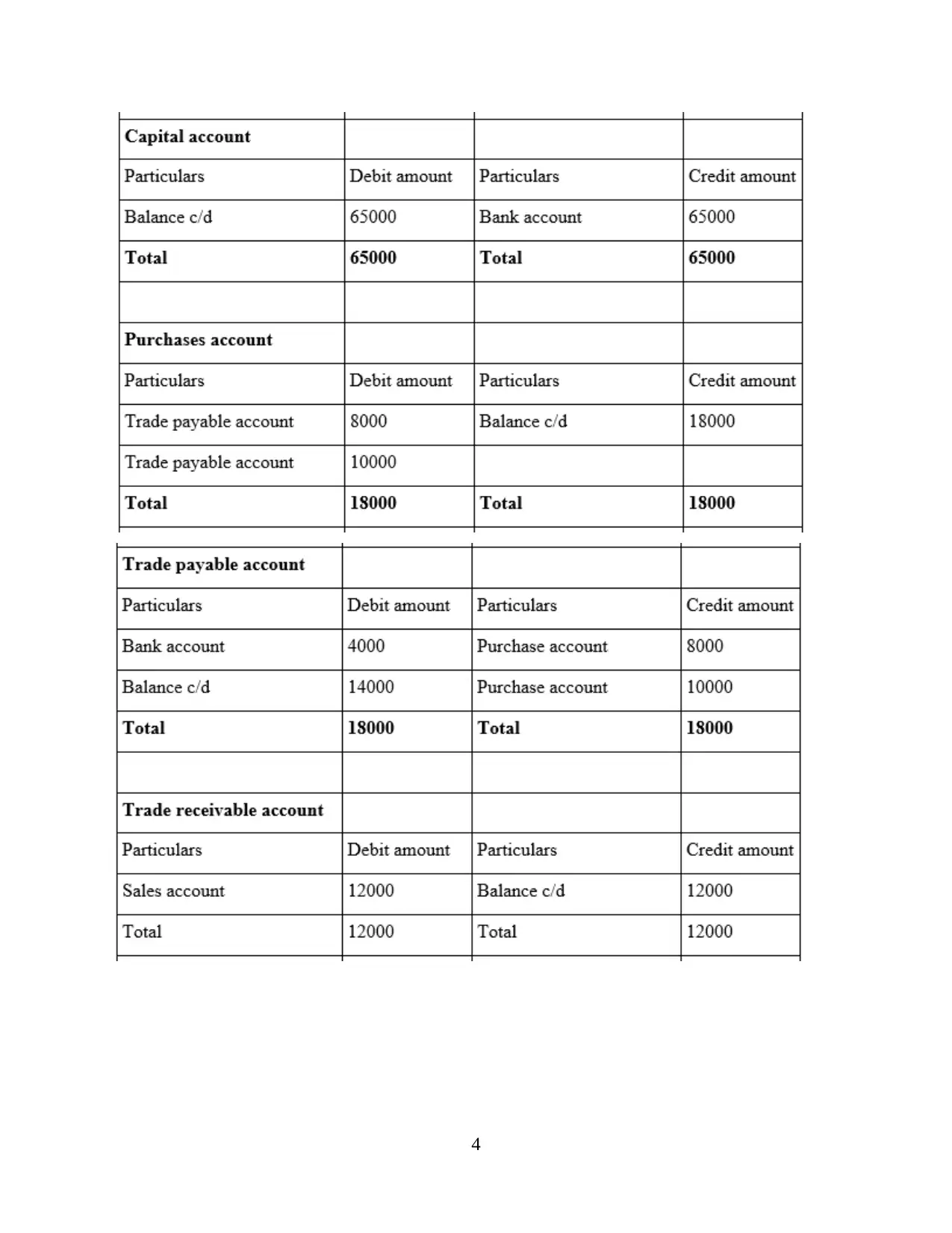
4
Paraphrase This Document
Need a fresh take? Get an instant paraphrase of this document with our AI Paraphraser
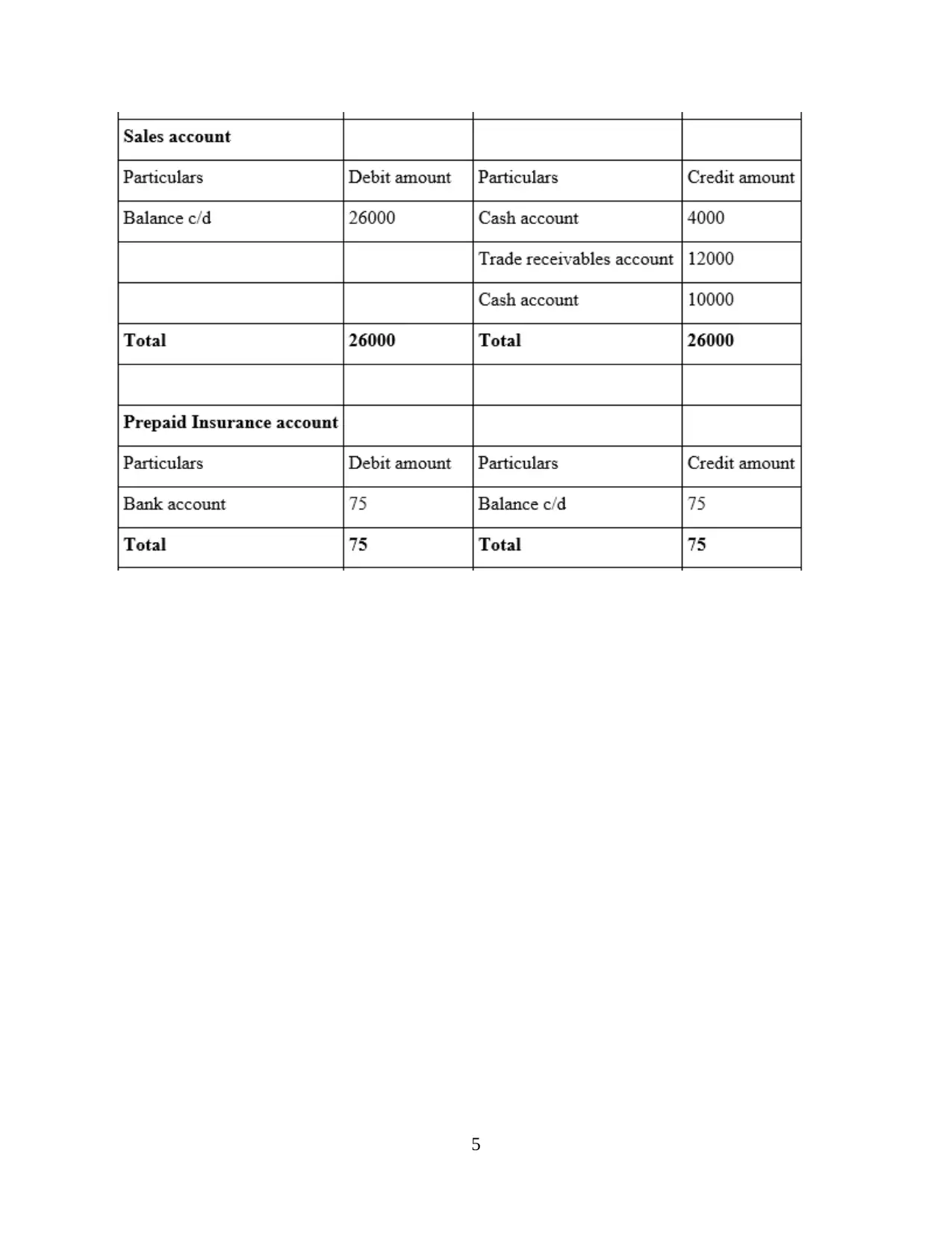
5

P2 Producing trail balance
Trial balance is a book keeping worksheet which balances all the ledger accounts by
classifying them into debit and credit. The main aim of this worksheet is to determine any error
which has occurred in recording transactions. Debit and credits should be equal is the core rule
of trial balance. Preparation of this statement is not a guarantee of correct and errorless statement
as there are few undetectable transactions which are not possible to detect using double entry
rule, they require intense evaluation and intense audit. Purpose of the trail balance is to develop a
ground for financial statements. Income statements and balance sheet re prepared using trail
balance. This worksheet ensures that all values are extracted from general ledgers and they also
assists in identification and rectification of errors. Trial balance of Muhammad's business is
developed below using above journal entries and general ledger:
Trail Balance
6
Trial balance is a book keeping worksheet which balances all the ledger accounts by
classifying them into debit and credit. The main aim of this worksheet is to determine any error
which has occurred in recording transactions. Debit and credits should be equal is the core rule
of trial balance. Preparation of this statement is not a guarantee of correct and errorless statement
as there are few undetectable transactions which are not possible to detect using double entry
rule, they require intense evaluation and intense audit. Purpose of the trail balance is to develop a
ground for financial statements. Income statements and balance sheet re prepared using trail
balance. This worksheet ensures that all values are extracted from general ledgers and they also
assists in identification and rectification of errors. Trial balance of Muhammad's business is
developed below using above journal entries and general ledger:
Trail Balance
6
⊘ This is a preview!⊘
Do you want full access?
Subscribe today to unlock all pages.

Trusted by 1+ million students worldwide
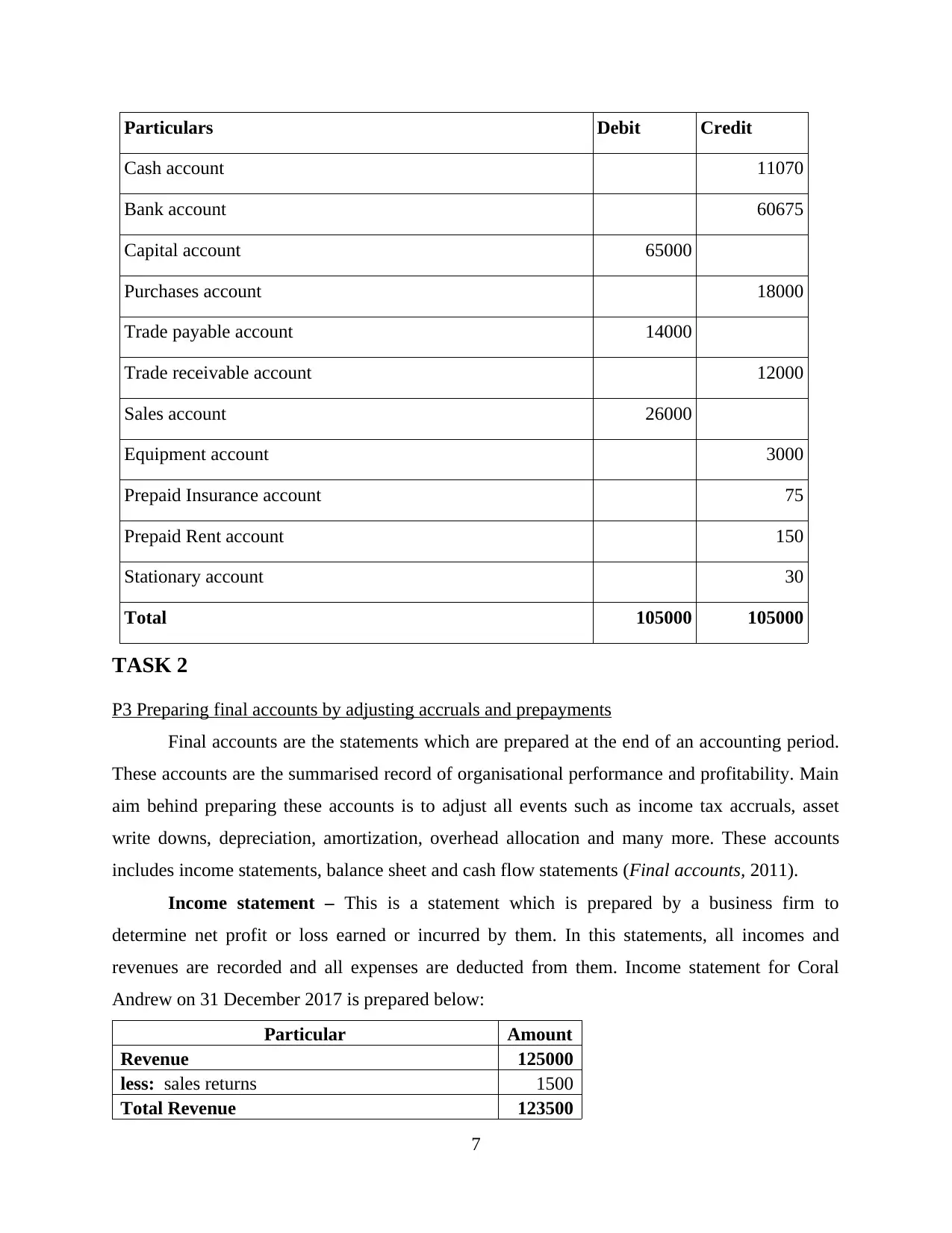
Particulars Debit Credit
Cash account 11070
Bank account 60675
Capital account 65000
Purchases account 18000
Trade payable account 14000
Trade receivable account 12000
Sales account 26000
Equipment account 3000
Prepaid Insurance account 75
Prepaid Rent account 150
Stationary account 30
Total 105000 105000
TASK 2
P3 Preparing final accounts by adjusting accruals and prepayments
Final accounts are the statements which are prepared at the end of an accounting period.
These accounts are the summarised record of organisational performance and profitability. Main
aim behind preparing these accounts is to adjust all events such as income tax accruals, asset
write downs, depreciation, amortization, overhead allocation and many more. These accounts
includes income statements, balance sheet and cash flow statements (Final accounts, 2011).
Income statement – This is a statement which is prepared by a business firm to
determine net profit or loss earned or incurred by them. In this statements, all incomes and
revenues are recorded and all expenses are deducted from them. Income statement for Coral
Andrew on 31 December 2017 is prepared below:
Particular Amount
Revenue 125000
less: sales returns 1500
Total Revenue 123500
7
Cash account 11070
Bank account 60675
Capital account 65000
Purchases account 18000
Trade payable account 14000
Trade receivable account 12000
Sales account 26000
Equipment account 3000
Prepaid Insurance account 75
Prepaid Rent account 150
Stationary account 30
Total 105000 105000
TASK 2
P3 Preparing final accounts by adjusting accruals and prepayments
Final accounts are the statements which are prepared at the end of an accounting period.
These accounts are the summarised record of organisational performance and profitability. Main
aim behind preparing these accounts is to adjust all events such as income tax accruals, asset
write downs, depreciation, amortization, overhead allocation and many more. These accounts
includes income statements, balance sheet and cash flow statements (Final accounts, 2011).
Income statement – This is a statement which is prepared by a business firm to
determine net profit or loss earned or incurred by them. In this statements, all incomes and
revenues are recorded and all expenses are deducted from them. Income statement for Coral
Andrew on 31 December 2017 is prepared below:
Particular Amount
Revenue 125000
less: sales returns 1500
Total Revenue 123500
7
Paraphrase This Document
Need a fresh take? Get an instant paraphrase of this document with our AI Paraphraser
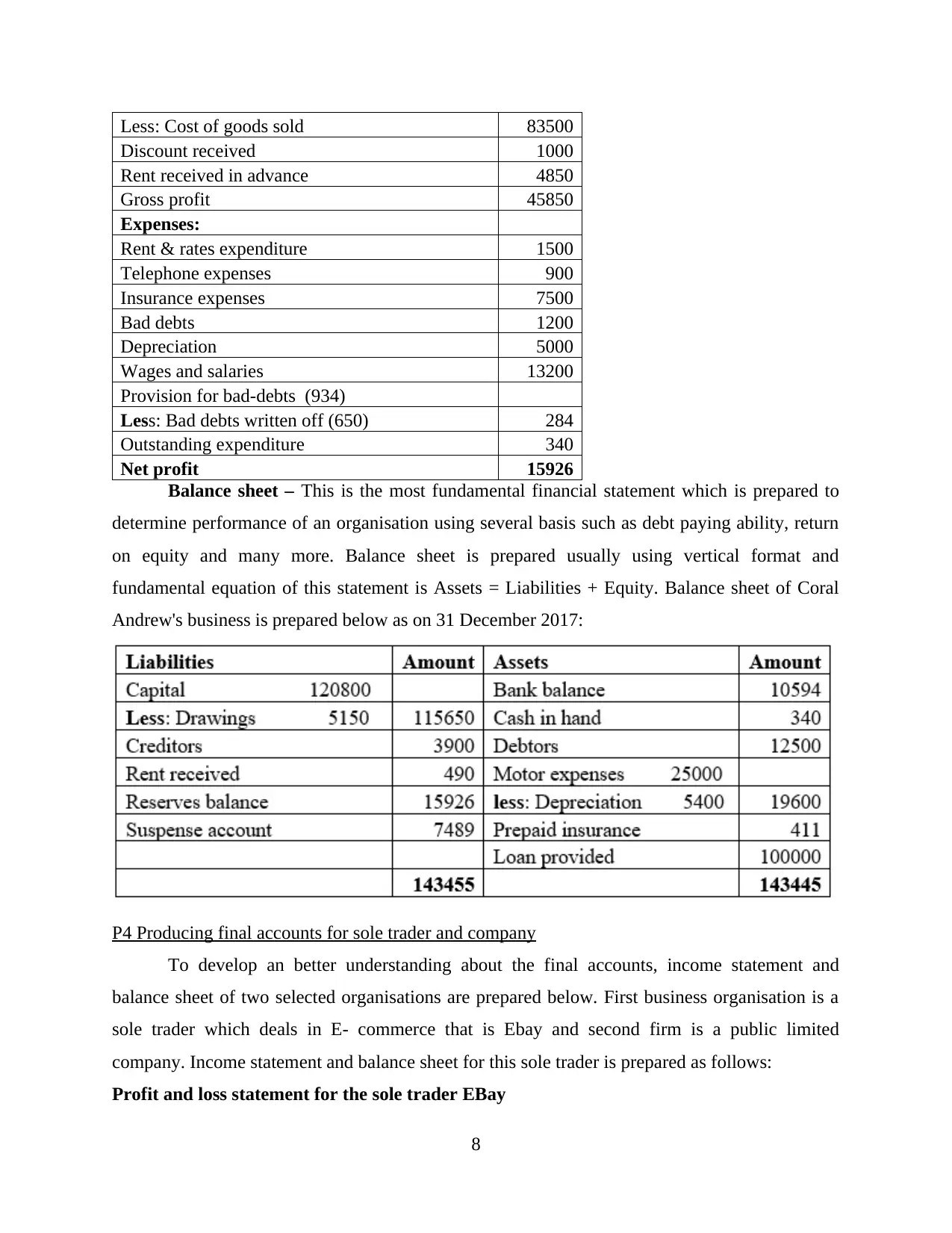
Less: Cost of goods sold 83500
Discount received 1000
Rent received in advance 4850
Gross profit 45850
Expenses:
Rent & rates expenditure 1500
Telephone expenses 900
Insurance expenses 7500
Bad debts 1200
Depreciation 5000
Wages and salaries 13200
Provision for bad-debts (934)
Less: Bad debts written off (650) 284
Outstanding expenditure 340
Net profit 15926
Balance sheet – This is the most fundamental financial statement which is prepared to
determine performance of an organisation using several basis such as debt paying ability, return
on equity and many more. Balance sheet is prepared usually using vertical format and
fundamental equation of this statement is Assets = Liabilities + Equity. Balance sheet of Coral
Andrew's business is prepared below as on 31 December 2017:
P4 Producing final accounts for sole trader and company
To develop an better understanding about the final accounts, income statement and
balance sheet of two selected organisations are prepared below. First business organisation is a
sole trader which deals in E- commerce that is Ebay and second firm is a public limited
company. Income statement and balance sheet for this sole trader is prepared as follows:
Profit and loss statement for the sole trader EBay
8
Discount received 1000
Rent received in advance 4850
Gross profit 45850
Expenses:
Rent & rates expenditure 1500
Telephone expenses 900
Insurance expenses 7500
Bad debts 1200
Depreciation 5000
Wages and salaries 13200
Provision for bad-debts (934)
Less: Bad debts written off (650) 284
Outstanding expenditure 340
Net profit 15926
Balance sheet – This is the most fundamental financial statement which is prepared to
determine performance of an organisation using several basis such as debt paying ability, return
on equity and many more. Balance sheet is prepared usually using vertical format and
fundamental equation of this statement is Assets = Liabilities + Equity. Balance sheet of Coral
Andrew's business is prepared below as on 31 December 2017:
P4 Producing final accounts for sole trader and company
To develop an better understanding about the final accounts, income statement and
balance sheet of two selected organisations are prepared below. First business organisation is a
sole trader which deals in E- commerce that is Ebay and second firm is a public limited
company. Income statement and balance sheet for this sole trader is prepared as follows:
Profit and loss statement for the sole trader EBay
8

Balance sheet of sole trader of EBay
9
9
⊘ This is a preview!⊘
Do you want full access?
Subscribe today to unlock all pages.

Trusted by 1+ million students worldwide
1 out of 17
Related Documents
Your All-in-One AI-Powered Toolkit for Academic Success.
+13062052269
info@desklib.com
Available 24*7 on WhatsApp / Email
![[object Object]](/_next/static/media/star-bottom.7253800d.svg)
Unlock your academic potential
Copyright © 2020–2025 A2Z Services. All Rights Reserved. Developed and managed by ZUCOL.





